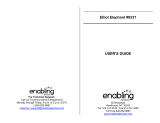
Introduction, Rev. 0
Freescale Semiconductor 1-1
Preliminary
Chapter 1
Introduction
The 56F8013 Demonstration Board is used to demonstrate the abilities of the 56F8013 digital
signal controller and to provide a hardware tool allowing the development of applications.
The 56F8013 Demonstration Board is an evaluation module board that includes a 56F8013 part,
RS-232 interface, user LEDs, user pushbutton switches and a daughter card connector. The
daughter card connector allows signal monitoring and expandability of user features.
The 56F8013 Demonstration Board is designed for the following purposes:
• Allowing new users to become familiar with the features of the 56800E architecture. The
tools and examples provided with the 56F8013 Demonstration Board facilitate evaluation
of the feature set and the benefits of the family.
• Serving as a platform for real-time software development. The tool suite enables the user
to develop and simulate routines, download the software to on-chip memory, run it, and
debug it using a debugger via the JTAG/Enhanced OnCE (EOnCE) port. The breakpoint
features of the EOnCE port enable the user to easily specify complex break conditions and
to execute user-developed software at full speed until the break conditions are satisfied.
The ability to examine and modify all user-accessible registers, memory and peripherals
through the EOnCE port greatly facilitates the task of the developer.
• Serving as a platform for hardware development. The hardware platform enables the user
to connect external hardware peripherals. The on-board peripherals can be disabled,
providing the user with the ability to reassign any and all of the processor's peripherals.
The EOnCE port's unobtrusive design means that all memory on the board and on the
processor is available to the user.
1.1 56F8013 Demonstration Board Architecture
The 56F8013 Demonstration Board facilitates the evaluation of various features present in the
56F8013 part. The 56F8013 Demonstration Board can be used to develop real-time software and
hardware products. The 56F8013 Demonstration Board provides the features necessary for a




















